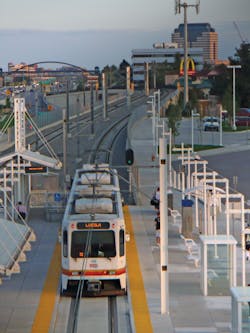With leaders, business owners and residents in metropolitan areas across the country grappling with a litany of economic, social and pollution issues, a major weapon against these issues is getting more and more discussion — mass transit.
Transit lines were integral parts of the building of American cities in the 1800s and 1900s, however, many of them fell by the wayside as cars went into vogue and expressways were built in the 1950s. However, cities soon began to see their economic and population bases fall with urban sprawl to surrounding suburbs while commute times ballooned and air pollution rates soared due to high traffic counts.
And in the past 30 years obesity rates have also skyrocketed in the country due in part to citizens becoming more reliant on cars rather than mass transit and walking.
But the concept of transit-oriented development is gaining traction in cities across the country where areas are beginning to see new growth for the first time in decades while looking to tackle some of the social issues plaguing residents.
The concept of transit-oriented development has been around for the past 15 to 20 years, where planners began to think about a return to old concepts that forged metropolitan areas. People living in cities had transit options in order to get to work or to shop and the need to have a car was reduced. Areas like New York City have held the concept, which other communities now look to bring back.
Catherine Cox Blair, program director for Reconnecting America, which advocates for TOD projects, said the idea helps planners meet the needs of building communities where people can get around without having to deal with the necessary infrastructure that goes along with heavy car traffic, such as large parking lots and parking garages, and a need for large amounts of gas stations in certain areas. She said the developments are also helping communities encourage their residents to lead a more active and healthier lifestyle.
“It doesn’t mean you’re making the cars obsolete,” she said. “You’re just lessening the dependence on them.”
Cox Blair said planning of transit-oriented developments are predominantly being planning on a site-by-site basis, but designers are now looking at designs on a corridor and regional scale in order to take a broader look at the impact of the developments and how they can serve residents and businesses.
Developments are also looking at the other modes of transportation available along the lines, such as bike and pedestrian paths, along with syncing residential areas with commercial areas.
“We find a amount of them have been pulling back the lens and are starting to look beyond the jurisdictional boundaries and are thinking about the network and the types of places and making sure you’ve got the local jurisdictions and the transit working collaboratively,” she said.
Transit-oriented development is also not limited to existing lines or fixed line transit, with both having their own sets of challenges for planners looking to knit different stops together more cohesively. Cox Blair said one of the top factors in planning a TOD development along either an existing or planned route is getting all of the stakeholders together to make sure business and resident needs are being met along the line and to plan future economic development on the lines.
She cited the Twin Cities central corridor connecting downtown Minneapolis to downtown St. Paul as a successful engagement of the community, where some residents who didn’t have stops even petitioned at the federal level until three more were added.
And in Denver, residents along the proposed station at Broadway and I-25 petitioned planners because they were afraid of a lack of affordable housing and plans to allow large retailers in the area, such as Target or Walmart.
“It’s critical for a number of reasons,” she said. “You want to engage the residents and businesses and property owners because really they’re the ones getting impacted by the changes both negative and positive.”
Although funds for transit programs are competitive in general, Cox Blair said the U.S. departments of Housing and Urban Development, transportation and Environmental Protection Agency have been very supportive of TOD projects and working to provide additional grants and resources for the growing number of projects.
One of the most important grants available for TOD projects is HUD’s sustainable regional planning grants, Cox Blair said, because it uses transit as an underlying mechanism for communities of all sizes.
“It’s probably trendier than most people would think,” she said.
A New Look at Growth in Philadelphia
Gary Jastrzab, executive director of the Philadelphia Planning Commission, said that city recently adopted a new zoning code slated to go into effect in August. It’s the first major revision of the code in 50 years and it calls for a city vision for 18 districts and uses TOD development as an overlay in this new plan. While the areas for TOD plans are still being worked out in many parts of the city, he said a number of developments have already gotten off the ground and shown benefits to areas of the city.
The new zoning code will promote density and development incentives in and around major transit stations and in the next three to four years the city will have TOD overlay plans mapped in the districts in order to spur more density.
In the Germantown area of Philadelphia, planners are currently working on TOD plans surrounding a regional rail station in that area in order to promote new development in the area of office and residential units using historic buildings that could be easily converted.
He said Philadelphia’s Planning Commission recently approved redevelopment plans near a subway station at Broad Street and South Street at the edge of the downtown area, which combines residential and commercial units on the ground floor long with underground parking. While past projects contained a ratio of 70 percent parking spaces to residential units, Jastrzab said this project will have half as many because of the access to transit.
While many of the developments near transit areas are private, Jastrzab said those taking place near the Paseo Verde rail station by Temple University has been developed between partnerships with public and private entities, along with community advocate organizations. The university has changed in nature in recent years and developments have been going up on the eastern edge of the campus.
“It’s not an area where we had to do any kind of major rezoning or permitting mainly because it’s adjacent to a regional rail station. Temple has really changed its character in the last 15 years or so of being a regional community school to a school where a lot of residential development is occurring around it, some of it spurred in due part to the private market really kicking in in a major way the past five years or so. We’re seeing a lot of small, infill projects and renovations in and around the eastern boundary of Temple in combination with the station.”
When the national economy collapsed in 2008 Jastrzab said a lot of the development plans in Philadelphia went on hiatus, but planners are beginning to see a lot of activity for new housing and commercial developments and transit will be a strong part of many of the projects as planning moves forward.
He said there has been a lot interest in new residential projects near the city’s center in the past several years because the area is well served by subway and regional rail lines coming into the downtown area.
“At this point the economy seems to be improving here and we’ve seen the city population increase really for the first time in 50 years. The census bureau also said the population as of July 2011 showed another population gain in the past year, so our city center area and a lot of residential areas immediately surrounding are really beginning to see a lot of activity.”
About the Author
Joe Petrie
Associate Editor
I came to Mass Transit in 2013 after spending seven years on the daily newsbeat in southeastern Wisconsin.
Based in Milwaukee, I worked as a daily newspaper reporter with the Waukesha Freeman from 2006-2011, where I covered education, county and state government. I went on to cover courts for Patch.com, where I was the main courts reporter in the Metro Milwaukee cluster of websites.
I’ve won multiple awards during the course of my career and have covered some of the biggest political events in the past decade and have appeared on national programs.
Having covered local government and social issues, I discovered the importance of transit and the impact it can have on communities when implemented, supported and funded.

